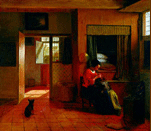










19.
“Patterne” and “Partes”: Exploring Hierarchies
of Reception in Early Modern Textual
and Visual Representations of Women
Organizers:
Description:
The workshop’s primary source readings–as provided by conveners
and participants–will drive the group’s discussion. We will use
brief excerpts from Sharon Achinstein’s “Women on top in the pamphlet
literature of the English Revolution” and Nancy Vickers’ “Diana
Described: Scattered Woman and Scattered Rhyme” as comparative critical
context for those primary source readings. We will ask that workshop participants
submit prior to the workshop one or two questions each that respond to the
readings and connect issues embedded in the readings and the workshop topic
with their own work. We will ask as well that each participant send to the
conveners ahead of time, for distribution, a page of quotations, images, or
short primary source material that will bring the discussion home to each
participant's own work in progress. We are particularly eager to see a rich
mix of verbal and visual texts represented in this workshop.
The discussion will be divided into two segments, each of which will include brief introductions by the conveners (taking up no more than ten minutes of each segment), framing the segment by highlighting the topical issues raised by the advance readings (five minutes) and initiating discussion of the pertinence of the workshop material to individual scholarship by locating “pattern” and “parts” as historical paradigms and analytical tools within the conveners’ own work (five minutes). We will then move to a broader-based discussion of the readings in the context of the questions prepared by each workshop attendee. Finally, at least half of each segment will be given to a discussion more explicitly based on the scholarly issues and problems being confronted by each workshop participant in his or her own work and on the roles played by pattern and parts within those specific scholarly frameworks.
The first segment will begin with a brief discussion of the reading from Achinstein and the use of the structural metaphors of pattern and parts in texts from the English Civil War and Commonwealth period (1640s and 1650s), exemplified in brief excerpts from one woman’s petition to Parliament in 1642 and short paragraphs taken from several political pamphlets of the period. Each of these primary sources focuses on the patterns of political rhetoric – the patterns of speech referred to in the workshop summary -- and the parts of the female body as a point of reference for the articulation of national crisis. The remainder of this discussion period will be devoted to conversation about the relevance of pattern and parts to participants’ own work, using as jumping off points their prepared questions and comments on the readings and the trends developing in the emerging discussion.
The second segment will build on the work accomplished in the first to make the transition from a focus on the rhetoric of reception within the written text to a focus on the textuality of images, themselves, as articulations of the reception of men and women. In this segment we will begin by looking at four images -- two examples each of seventeenth-century male and female English and Italian series portraits -- contextualized by two brief excerpts from lay arts-related treatises of the same period. Here we will consider the metaphor of “pattern” as it relates to the role of the portrait image as exemplar, and pick up on the earlier exploration of “parts” as relating to the deconstruction of the female body and image. We anticipate moving from discussion of these primary source materials into a broader discussion of the roles played by the concepts of pattern and parts in framing contemporaries’ readings of post-Renaissance portrait images and of the female subjectivities commented upon by them. Again, the bulk of the second discussion period will be given to continued conversation about participants’ own work, now against the backdrop of the relevance of pattern and parts to analysis of both verbal and visual texts.
The particular textual and visual cases with which we open each segment will enable us to frame and begin discussing such questions as the following:
Readings:
Primary Source Readings:
Excerpts from:
Excerpts from the following, each no more than one half page in length, for a total length of no more than 3 pages:
Critical Readings:
Excerpts (totaling no more than 15 pages) from the following two essays, both reprinted in Feminism and Renaissance Studies, edited by Lorna Hutson (Oxford, New York: Oxford University Press, 1999):
Sharon Achinstein, “Women on top in the pamphlet literature of the English Revolution”;
|
|
|
||||||
|
|
 |
 |
|
||||
 |
|
 |
|
||||
|
|
|
||||||
|
|
|
||||||
 |
|
||||||
|
|
|
||||||
| |
|
||||||
 |
|
||||||
 |
|
||||||
 |
|
||||||
 |
|
||||||
|
|
|
||||||
|
|
 |
|
|
||||
 |
|
||||||
|
|
|
|
|
|
|
|
|